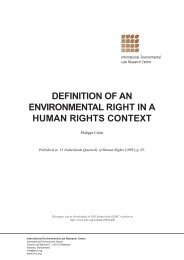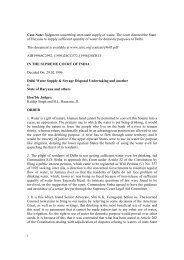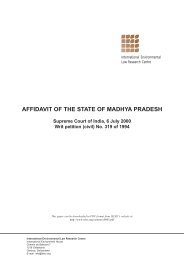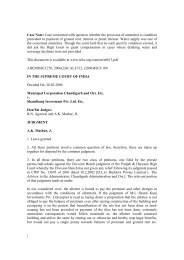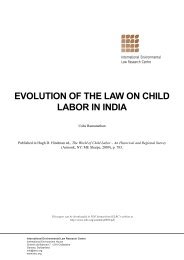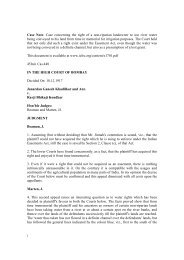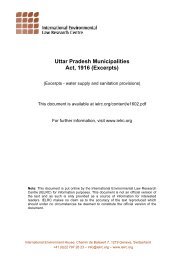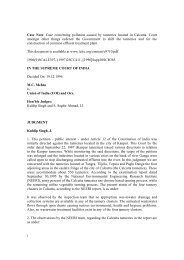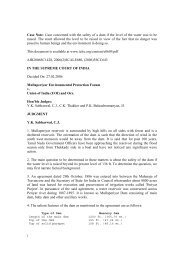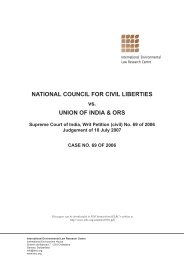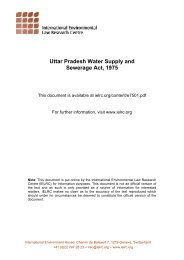international border with Pakistan both in Gujarat and Rajasthan to encourage sturdy peasants tosettle in these border areas (later events have confirmed the imperative need for this); and5. All available water should be utilised to the maximum extent possible for irrigation and powergeneration and, when no irrigation is possible, for power generation. The quantity going waste tothe sea without doing irrigation or generating power should be kept to the unavoidable minimum.42. The Master Plan recommended by the Khosla Committee envisaged 12 major projects to be taken up inMadhya Pradesh and one, viz., Navagam in Gujarat. As far as Navagam Dam is concerned, the Committeerecommended as follows:1. The terminal dam should be located at Navagam,2. The optimum FRL <strong>of</strong> the Navagam worked out to RL 500 ft,3. The FSL (Full Supply Level) <strong>of</strong> the Navagam canal at <strong>of</strong>f-take should be RL 300 ft,4. The installed capacity at the river bed power station and canal power station should be 1000 MW and 240MW respectively with one stand-by unit in each power station (in other words the total installed capacity atNavagam would be 1,400 MW).The benefits <strong>of</strong> the Navagam Dam as assessed by the Khosla Committee were as follows:(i) Irrigation <strong>of</strong> 15.80 lakh hectares (39.4 lakh acres) in Gujarat and 0.4 lakh hectares (1.00 lakh acres)in Rajasthan. In addition, the <strong>Narmada</strong> waters when fed into the existing Mahi canal system wouldrelease Mahi water to be diverted on higher contours enabling additional irrigation <strong>of</strong> 1.6 to 2.0 lakhhectares (4 to 5 lakh acres) approximately in Gujarat and 3.04 lakh hectares (7.5 lakh acres) in Rajasthan.(ii) Hydro-power generation <strong>of</strong> 951 MW at 60 percent LF in the mean year <strong>of</strong> development and 511 MWon ultimate development <strong>of</strong> irrigation in Gujarat, Madhya Pradesh, Maharashtra and Rajasthan.43. The Khosla Committee stressed an important point in favour <strong>of</strong> a high Navagam Dam, namely, additionalstorage. They emphasised that this additional storage will permit greater carryover capacity, increased powerproduction and assured optimum irrigation and flood control and would minimise the wastage <strong>of</strong> water to the sea.The Khosla Committee also observed that instead <strong>of</strong> higher Navagam Dam as proposed, if Harinphal or Jalsindhidams were raised to the same FRL as at Navagam, the submergence would continue to remain about the samebecause the cultivated and inhabited areas lie mostly above Harinphal while in the intervening 113 km (70 mile)gorge between Harinphal and Navagam, there was very little habitation or cultivated areas.44. The Khosla Committee report could not be implemented on account <strong>of</strong> disagreement among the States. On 6July 1968 the State <strong>of</strong> Gujarat made a complaint to the Government <strong>of</strong> <strong>India</strong> under Section 3 <strong>of</strong> the Inter-StateWater Disputes Act, 1956 stating that a water dispute had arisen between the State <strong>of</strong> Gujarat and the respondentStates <strong>of</strong> Madhya Pradesh and Maharashtra over the use, distribution and control <strong>of</strong> the waters <strong>of</strong> the inter-stateriver <strong>Narmada</strong>. The substance <strong>of</strong> the allegation was that executive action had been taken by Maharashtra andMadhya Pradesh which had prejudicially affected the State <strong>of</strong> Gujarat and its inhabitants. The State <strong>of</strong> Gujaratobjected to the proposal <strong>of</strong> the State <strong>of</strong> Madhya Pradesh to construct Maheshwar and Harinphal Dams over theriver <strong>Narmada</strong> in its lower reach and also to the agreement reached between the States <strong>of</strong> Madhya Pradesh andMaharashtra to jointly construct the Jalsindhi Dam over <strong>Narmada</strong> in its course between the two States. The mainreason for the objection was that if these projects were implemented, the same would prejudicially affect the rightsand interests <strong>of</strong> Gujarat State by compelling it to restrict the height <strong>of</strong> the dam at Navagam to FRL 210 ft or less.Reducing the height <strong>of</strong> the dam would mean the permanent detriment <strong>of</strong> irrigation and power benefits that wouldbe available to the inhabitants <strong>of</strong> Gujarat and this would also make it impossible for Gujarat to reclaim the desertarea in the Ranns <strong>of</strong> Kachchh. According to the State <strong>of</strong> Gujarat, the principal matters in disputes were as under:i. The right <strong>of</strong> the State <strong>of</strong> Gujarat to control and use the waters <strong>of</strong> the <strong>Narmada</strong> River on well-acceptedprinciples applicable to the use <strong>of</strong> waters <strong>of</strong> inter-State rivers;ii. The right <strong>of</strong> the State <strong>of</strong> Gujarat to object to the arrangement between the State <strong>of</strong> Madhya Pradesh and theState <strong>of</strong> Maharashtra for the development <strong>of</strong> Jalsindhi Dam;3
iii. The right <strong>of</strong> the State <strong>of</strong> Gujarat to raise the Navagam dam to an optimum height commensurate with theefficient use <strong>of</strong> <strong>Narmada</strong> waters including its control for providing requisite cushion for flood control; andiv. The consequential right <strong>of</strong> submergence <strong>of</strong> area in the States <strong>of</strong> Madhya Pradesh and Maharashtra andareas in the Gujarat State.45. Acting under Section 4 <strong>of</strong> the Inter-State Water Disputes Act, 1956, the Government <strong>of</strong> <strong>India</strong> constituted aTribunal headed by the Hon’ble Mr Justice V Ramaswamy, a retired Judge <strong>of</strong> this Court. On the same day, theGovernment made a reference <strong>of</strong> the water dispute to the Tribunal. The Reference being in the following terms:In exercise <strong>of</strong> the powers conferred by sub-section (1) <strong>of</strong> Section 5 <strong>of</strong> the Inter-State Water Disputes Act,1956 (33 <strong>of</strong> 1956), the Central Government hereby refers to the <strong>Narmada</strong> Water Disputes Tribunal foradjudication <strong>of</strong> the water dispute regarding the inter-state river, <strong>Narmada</strong>, and the river-valley there<strong>of</strong>,emerging from letter No. MIP-5565/C-10527-K dated 6 July 1968, from Gujarat.46. On 16 October 1969, the Government <strong>of</strong> <strong>India</strong> made another reference <strong>of</strong> certain issues raised by the State <strong>of</strong>Rajasthan to the said tribunal.47. The State <strong>of</strong> Madhya Pradesh filed a Demurrer before the Tribunal stating that the constitution <strong>of</strong> the Tribunaland reference to it were ultra vires <strong>of</strong> the Act. The Tribunal framed 24 issues which included the issues relating tothe Gujarat having a right to construct a high dam with FRL 530 ft and a canal with FSL 300 ft or thereabouts.Issues 1(a), 1(b), 1(A), 2, 3, and 19 were tried as preliminary issues <strong>of</strong> law and by its decision dated 23 February1972, the said issues were decided against the respondents herein. It was held that the Notification <strong>of</strong> the CentralGovernment dated 16 October 1969 referring the matters raised by the State <strong>of</strong> Rajasthan by its complaint wasultra vires <strong>of</strong> the Act but constitution <strong>of</strong> Tribunal and making a reference <strong>of</strong> the water dispute regarding the Inter-State river <strong>Narmada</strong> was not ultra vires <strong>of</strong> the Act and the Tribunal had jurisdiction to decide the dispute referredto it at the instance <strong>of</strong> State <strong>of</strong> Gujarat. It further held that the proposed construction <strong>of</strong> Navagam project involvingconsequent submergence <strong>of</strong> portions <strong>of</strong> territories <strong>of</strong> Maharashtra and Madhya Pradesh could form the subjectmatter <strong>of</strong> a water dispute within the meaning <strong>of</strong> Section 2(c) <strong>of</strong> the 1956 Act. It also held that it had the jurisdictionto give appropriate direction to Madhya Pradesh and Maharashtra to take steps by way <strong>of</strong> acquisition or otherwisefor making submerged land available to Gujarat in order to enable it to execute the Navagam Project and theTribunal had the jurisdiction to give consequent directions to Gujarat and other party States regarding payment <strong>of</strong>compensation to Maharashtra and Madhya Pradesh, for giving them a share in the beneficial use <strong>of</strong> Navagam dam,and for rehabilitation <strong>of</strong> displaced persons.48. Against the aforesaid judgment <strong>of</strong> the Tribunal on the preliminary issues, the States <strong>of</strong> Madhya Pradesh andRajasthan filed appeals by special leave to this Court and obtained a stay <strong>of</strong> the proceedings before the Tribunal toa limited extent. This Court directed that the proceedings before the Tribunal should be stayed but discovery,inspection and other miscellaneous proceedings before the Tribunal may go on. The State <strong>of</strong> Rajasthan was directedto participate in these interlocutory proceedings.49. It appears that on 31.7.1972, the Chief Ministers <strong>of</strong> Madhya Pradesh, Maharashtra, Gujarat and Rajasthan hadentered into an agreement to compromise the matters in dispute with the assistance <strong>of</strong> the Prime Minister <strong>of</strong> <strong>India</strong>.This led to a formal agreement dated 12 July 1974 being arrived at between the Chief Ministers <strong>of</strong> MadhyaPradesh, Maharashtra and Rajasthan and the Advisor <strong>of</strong> the Governor <strong>of</strong> Gujarat on a number <strong>of</strong> issues which theTribunal otherwise would have had to go into. The main features <strong>of</strong> the Agreement, as far as this case is concerned,were that the quantity <strong>of</strong> water in <strong>Narmada</strong> available for 75 percent <strong>of</strong> the year was to be assessed at 28 MAF andthe Tribunal in determining the disputes referred to it was to proceed on the basis <strong>of</strong> this assessment. The netavailable quantity <strong>of</strong> water for use in Madhya Pradesh and Gujarat was to be regarded as 27.25 MAF which was tobe allocated between the States. The height <strong>of</strong> the Navagam Dam was to be fixed by the Tribunal after taking intoconsideration various contentions and submissions <strong>of</strong> the parties and it was agreed that the appeals filed in thisCourt by the States <strong>of</strong> Madhya Pradesh and Rajasthan would be withdrawn. It was also noted in this agreementthat ‘development <strong>of</strong> <strong>Narmada</strong> should no longer be delayed in the best regional and national interests’.50. After the withdrawal <strong>of</strong> the appeals by the States <strong>of</strong> Madhya Pradesh and Rajasthan, the Tribunal proceeded todecide the remaining issues between the parties.51. On 16 August 1978, the Tribunal declared its Award under Section 5(2) read with Section 5(4) <strong>of</strong> the Inter-State Water Disputes Act, 1956. Thereafter, reference numbers 1, 2, 3, 4 & 5 <strong>of</strong> 1978 were filed by the <strong>Union</strong> <strong>of</strong>4



